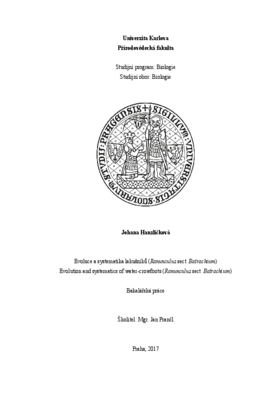Evoluce a systematika lakušníků (Ranunculus sect. Batrachium)
Evolution and systematics of water-crowfoots (Ranunculus sect. Batrachium)
bakalářská práce (OBHÁJENO)

Zobrazit/
Trvalý odkaz
http://hdl.handle.net/20.500.11956/85476Identifikátory
SIS: 185695
Kolekce
- Kvalifikační práce [21483]
Autor
Vedoucí práce
Oponent práce
Bílá, Jana
Fakulta / součást
Přírodovědecká fakulta
Obor
Biologie
Katedra / ústav / klinika
Katedra botaniky
Datum obhajoby
5. 6. 2017
Nakladatel
Univerzita Karlova, Přírodovědecká fakultaJazyk
Čeština
Známka
Výborně
Klíčová slova (česky)
Ranunculus sect. Batrachium, hybridizace, polyploidizace, kryptické taxony, Ranunculus trichophyllus aggKlíčová slova (anglicky)
Ranunculus sect. Batrachium, hybridization, polyploidization, cryptic taxa, Ranunculus trichophyllus aggSekce lakušník (Ranunculus sect. Batrachium) je jednou z nejvíce komplikovaných skupin vodních rostlin. Uplatňují se zde procesy polyploidizace (je známo celkem pět ploidních úrovní) a hybridizace, které se společně podílí na výsledné retikulátní evoluci celého rodu Ranunculus. Nově vzniklí hybridi a polyploidi mohou být navíc v přírodě fixováni díky klonálnímu růstu nebo autogamii. Fenotypová plasticita a značná morfologická redukce přispívají k taxonomické složitosti skupiny a v kombinaci s mikroevolučními procesy vedou k existenci kryptické variability v rámci sekce. Z těchto důvodů je možno říci, že současné taxonomické členění je nepřesné a vyžaduje zásadní revizi. Práce zahrnuje také stručný úvod ke kryptickému komplexu Ranunculus trichophyllus agg., jež bude předmětem navazující diplomové práce, a přehled metod, které budou při dalším studiu použity.
Water-crowfoots (Ranunculus sect. Batrachium) are among the most complicated groups of aquatic angiosperms. Processes such as polyploidization (there are five known ploidy levels) and hybridization play the main role in evolution of the subgenus, resulting into thereticulate evolution of the whole genus Ranunculus. Furthermore, newly established hybrids and polyploids can be fixed in nature via clonal growth or autogamy. Fenotypic plasticity and considerable morphological reduction contribute to the taxonomic complexity of the group and in combination with microevolutionary processes lead to the existence of cryptic variation.Therefore it can be said that the current taxonomic classification is dubious and requires a revision. The thesis also includes a brief introduction to the cryptic species complex Ranunculus trichophyllus agg. and a description of methods which will be applied in following master thesis.
Citace dokumentu
Metadata
Zobrazit celý záznamSouvisející záznamy
Zobrazují se záznamy příbuzné na základě názvu, autora a předmětu.
-
Zhodnocení kryptické diverzity ve skupině lakušníku niťolistého (Ranunculus trichophyllus agg.)
Výsledek obhajoby: OBHÁJENOHanzlíčková, Johana (Univerzita Karlova, Přírodovědecká fakulta, 2021)Datum obhajoby: 26. 5. 2021Ranunculus trichophyllus agg. (thread-leaved water crowfoot) represents a taxonomically challenging group of aquatic plants in which the presence of several significantly different genotypes and the genome size variation ... -
Příslušnost aecií na rodu Ranunculus k travním druhům rzí.
Výsledek obhajoby: OBHÁJENOHejná, Markéta (Univerzita Karlova, Přírodovědecká fakulta, 2006)Datum obhajoby: 14. 9. 2006 -
Travní druhy rzí s aecii na rodech Ranunculus a Ficaria - molekulární analýza
Výsledek obhajoby: OBHÁJENOHejná, Markéta (Univerzita Karlova, Přírodovědecká fakulta, 2008)Datum obhajoby: 23. 9. 2008
